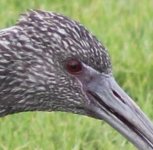I disagree with this. As I've said above, I'd go for reddish-brown or red-brown - and...Both the OPs have bright red eyes
Anyway, as we know, iris colour in anything can be pretty individually/seasonally/etc/etc variable - so no big deal (except that I certainly disagree that this bird's is 'bright red').eye looks brown in the last shot.
Good moult gen
Me too. As we've both said before. And I agree about the key criterion.Regardless of age, I think the OPs are almost certainly White-faced - the key criteria here being the diagnostic red irises.






